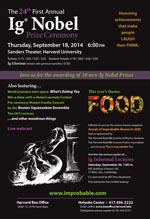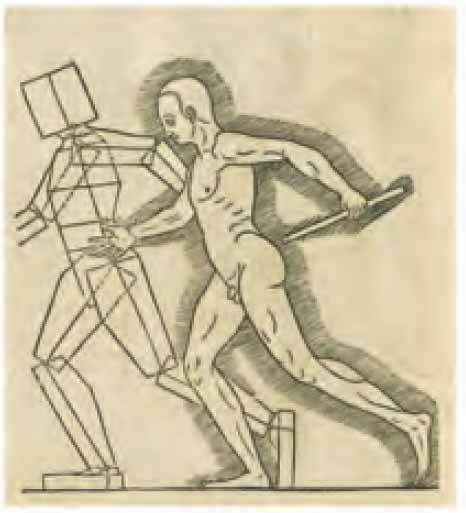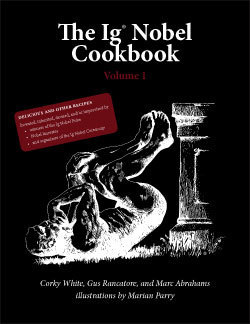Marc Abrahams's Blog, page 376
September 18, 2014
Here are the 2014 Ig Nobel Prize winners
The 2014 Ig Nobel Prize winners were introduced at the 24th First Annual Ig Nobel Prize ceremony, at Harvard’s Sanders Theatre.

Ig Nobel tonight!
The 24th First Annual Ig Nobel Prize ceremony happens tonight:
Thursday, September 18, 6:00 pm (US eastern time).
 Watch the live webcast
.
Watch the live webcast
.And…
Simultaneously follow the action on Twitter:
James Harkin (James is the head writer for QI, The Museum of Curiosity, and the podcast No Such Thing as a Fish) will be on stage, live-tweeting at @ImprobResearch
Lots of other people (maybe including you?) will be live tweeting at #IgNobel
Please spread the word!
Ps. Tickets to physically attend the ceremony are sold out. But… it’s possible that a very few tickets will become available in the last hours. If you’re willing to take a chance on that, check the Harvard Box Office web site, or, late in the afternoon, come to the ticket window at Harvard’s Sanders Theatre.

A logistics video: Automobile weaving
Here is another logistics video. The activities shown here can be modeled with standard mathematical techniques, should it appeal to you to do so:
(Thanks to investigator Vaughn Tan for bringing this to our attention.)

A past Ig Nobel winner recounts the glory (or whatever)
Laurent Bègue, who a year ago was (together with his colleagues) awarded the 2013 Ig Nobel Prize for psychology, recounts the experience. He writes, in the Huffington Post:
Le jour où j’ai reçu un IG Nobel
L’université américaine de Harvard décerne chaque année les LG Nobel. Ces prix récompensent des scientifiques dont les travaux font “rire, puis réfléchir”. Laurent Bègue, professeur à l’université de Grenoble et lauréat 2013, revient sur son expérience un an après.
Le message que j’ai trouvé dans ma boîte électronique, ce 14 avril 2013, était plus énigmatique que la moyenne. En tant qu’enseignant-chercheur à l’université, les courriels que je reçois sont parfois inattendus ou sibyllins (comme savent l’être les étudiants, sans parler de certains collègues) mais celui-ci l’était particulièrement: «Pourrions-nous avoir une conversation strictement confidentielle (par email ou téléphone) au sujet de votre article publié récemment dans le “British Journal of Psychology”». L’auteur de ce message matinal, un certain Kees Moeliker, se présentait comme le représentant européen du « bureau des recherches improbables ». Après avoir Gogglelisé le patronyme néerlandais de mon mystérieux correspondant, deux informations ressortaient : ce monsieur était ornithologiste à Rotterdam, et il avait été distingué pour ses travaux sur la nécrophilie homosexuelle chez le canard colvert.
Le ton était donné. J’apprenais qu’un récent papier sur l’effet placebo de l’alcool sur la perception de soi, publié avec plusieurs collègues de Paris, Grenoble et de l’université de l’Ohio, allait nous valoir un IG nobel (contraction de “Nobel” et de l’adjectif “ignoble”), prix redoutable quoique convoité et décerné annuellement depuis plus de vingt ans à l’université de Harvard à dix chercheurs de toutes disciplines dont les travaux font « rire les gens au premier abord, et ensuite les font réfléchir »….

Mozart’s “Don Giovanni” and the Ig Nobel Prize ceremony
So you love opera, and you think you know the heights and depths of “Là ci darem la mano” and of the finale — “the Commendatore scene” — in Mozart’s “Don Giovanni”?
Ha. Watch the live webcast of the 2014 Ig Nobel Prize ceremony, which includes (among many things) the premiere of the mini-opera “What’s Eating You”. “What’s Eating You” tells an entirely different story — a story that focuses far more than the original on food, and on hands. And on bacteria. It all comes together or (depending on which character you identify with) falls apart, in the thrilling final scene, which uses the music from the Commendatore scene.
The ceremony, with the webcast, begins at 6:00 pm (US eastern time), Thursday, September 18.
This video shows a performance of Mozart’s opera before we got hold of it:

September 17, 2014
Artists and their difficulties with gaits
Even the most accomplished artists sometimes have difficulty in accurately portraying human anatomy. Paul Cezzane, for instance, had trouble with hands (examples [1] [2] [3] ). Another persistently tricky area is highlighted (or, if you prefer, highlit) by Professor Julian Meltzoff of La Jolla, California,in a recent article for Psychology of Aesthetics, Creativity, and the Arts. see: ‘Errors in the Making and Perception of Art Images of Human Gait: Psychological Explanations.’ He points out that:
“Paintings, drawings, and sculptures from ancient art to the present reveal a curious error in the portrayal of human gait. In natural human gait the arm and leg on 1 side of the body swing in opposite directions to each other—contralaterally. The error is to depict the arm and leg on the same side of the body as if swinging in the same direction— homolaterally.“
 The professor draws particular attention to (presumably unintentional) portrayals of gait errors in ‘how to draw’ publications, which he says, “ […] has been largely unnoticed by art historians and nonexpert viewers”
The professor draws particular attention to (presumably unintentional) portrayals of gait errors in ‘how to draw’ publications, which he says, “ […] has been largely unnoticed by art historians and nonexpert viewers”
For example (pictured) Des Circkels und Richtscheyts auch der Perspectiva und Proportion der Menschen und Rosse kurze doch gründtliche underweisung des rechten gebrauchs: (by Heinrich Lautensack, 1618)

The Ig Nobel Cookbook (volume 1), in the flesh
 Our newest new book — The Ig Nobel Cookbook (volume 1) — is now available in the flesh, so to speak and so to read, in one of the world’s great bookstores.
Our newest new book — The Ig Nobel Cookbook (volume 1) — is now available in the flesh, so to speak and so to read, in one of the world’s great bookstores.
Harvard Bookstore has a print-on-demand machine. If you walk into the store, smile, and demand a copy of the book, they will print it for you, tout de suite. You can also order from Harvard Bookstore online, and by telephone.
Peggy Hernandez reviewed the book today in The Boston Globe, under the headline ”
CanBeSmart Curry and other unusual recipes from ‘Ig Nobel Cookbook’
The Ig Nobel Cookbook (volume 1) is also available from Amazon.com, and soon in other good places.
The Ig® Nobel Cookbook
Volume 1Corky White, Gus Rancatore, and Marc Abrahams
illustrations by Marian ParryDelicious and other recipes invented, inherited, devised, and/or improvised by
• winners of the Ig Nobel Prize
• Nobel laureates
• and organizers of the Ig Nobel Ceremony
BONUS: Our almost-newest new book, This Is Improbable Too, is on sale at those places, too, as is the predecessor book, This Is Improbable.
BONUS: PRI’s “The World” radio reports about the book.

September 16, 2014
Press at the Ig: Glimpses of the Russian TV coverage
Every year, at the Ig Nobel Prize ceremony, Sanders Theatre is jammed not only with Ig Nobel winners, Nobel winners, opera singers, and 1100 audience members, but also with journalists who come from afar to document the doings.
Channel One Russia is among the many international TV networks sending crews to this year’s Ig Nobel Prize ceremony on Thursday, September 18. Here are three of Channel One Russia’s reports about previous Ig Nobel ceremonies:
2011:
2012:
2013:

Further past investigations of spaghetti
Investigating how and why a strand of uncooked spaghetti breaks after bending — well that’s a complicated undertaking, with a rich history. One man’s take appears in this writeup:
“The dynamics of linear spaghetti structures — how one thing just leads to another,” RWD Nickalls, 14 June, 2006. The author is at the Department of Anaesthesia, Nottingham University Hospitals, City Hospital Campus, Nottingham, UK.
The 2006 Ig Nobel Prize in physics centered on this very topic. The prize was awarded to Basile Audoly and Sebastien Neukirch of the Université Pierre et Marie Curie, in Paris, for their insights into why, when you bend dry spaghetti, it often breaks into more than two pieces. [REFERENCE: "Fragmentation of Rods by Cascading Cracks: Why Spaghetti Does Not Break in Half," Basile Audoly and Sebastien Neukirch, Physical Review Letters, vol. 95, no. 9, August 26, 2005, pp. 95505-1 to 95505-1.]

This year’s 24/7 Lecturers
Here’s the lineup of 24/7 Lecturers at this year’s Ig Nobel Prize ceremony. You’ll see them Thursday evening, September 18, if you come to the ceremony at Harvard’s Sanders Theatre, or if you watch the live webcast.
What, you ask, are the 24/7 Lectures?
This: several of the world’s top thinkers each explains her or his subject twice:
FIRST : a complete technical description in TWENTY-FOUR (24) SECONDS**
AND THEN: a clear summary that anyone can understand, in SEVEN (7) WORDS
This year’s 24/7 Lecturers:
Martin Chalfie (Nobel laureate, chemistry): BIOLUMINESCENCE
Carol Greider (Nobel laureate, physiology or medicine). Topic: TELOMERES
Eric Maskin (Nobel laureate, economics): INCOME INEQUALITY
Rob Rhinehart (founder, Soylent). Topic: METABOLISM
Corky White (Professor of Anthropology, Boston University). Topic: FOOD
The history of the 24/7 Lectures is full of surprising people and ideas you may know, and others you might like to get to know.
** Time limits will be enforced by the the referee, Mr. John Barrett
Here’s video of three 24/7 Lecture from the past — Eric Lander (GENOME), Dany Adams (BIOLOGY), and Benoit Mandelbrot (FRACTALS):

Marc Abrahams's Blog
- Marc Abrahams's profile
- 14 followers



